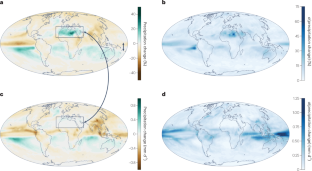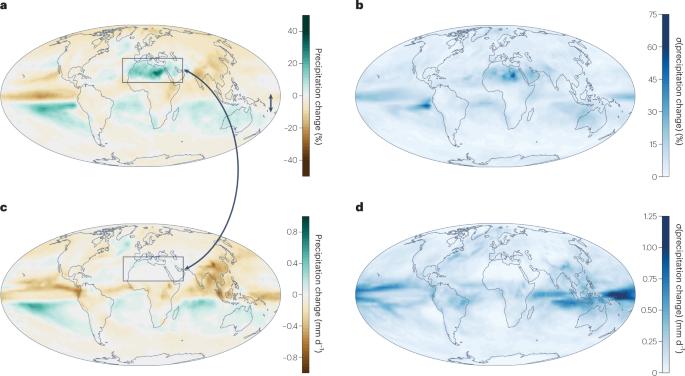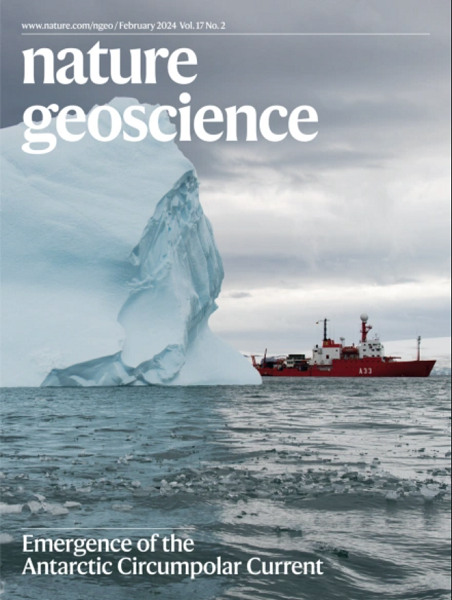气溶胶对降水的多方面影响
IF 15.7
1区 地球科学
Q1 GEOSCIENCES, MULTIDISCIPLINARY
引用次数: 0
摘要
气溶胶被认为会影响降水率和从单个云层到全球的降水空间模式。然而,在跨时空尺度的多种效应的基本机制和重要性方面仍存在很大的不确定性。在此,我们回顾了这些效应背后的证据和科学共识,这些效应分为通过改变辐射通量和能量平衡产生的辐射效应,以及通过改变云滴和冰晶产生的微物理效应。广泛的共识和有力的理论证据表明,气溶胶辐射效应(气溶胶-辐射相互作用和气溶胶-云相互作用)是降水变化的驱动因素,因为全球平均降水量受到能量和地表蒸发的制约。同样,气溶胶辐射效应导致大尺度降水模式(如热带辐合带)的变化也是有据可查的。气溶胶对较小尺度降水的影响程度则不太清楚。尽管有广泛的共识和有力的证据表明,气溶胶扰动在微观物理上增加了云滴数量,减小了云滴尺寸,从而减缓了降水水滴的形成,但气溶胶对不同尺度降水的总体影响仍然存在很大的不确定性。全球云解析模式为研究目前全球气候模式没有很好体现的机制以及将局部效应与更大尺度紧密联系起来提供了机会。这将增强我们对气候变化预测影响的信心。本文章由计算机程序翻译,如有差异,请以英文原文为准。


Multifaceted aerosol effects on precipitation
Aerosols have been proposed to influence precipitation rates and spatial patterns from scales of individual clouds to the globe. However, large uncertainty remains regarding the underlying mechanisms and importance of multiple effects across spatial and temporal scales. Here we review the evidence and scientific consensus behind these effects, categorized into radiative effects via modification of radiative fluxes and the energy balance, and microphysical effects via modification of cloud droplets and ice crystals. Broad consensus and strong theoretical evidence exist that aerosol radiative effects (aerosol–radiation interactions and aerosol–cloud interactions) act as drivers of precipitation changes because global mean precipitation is constrained by energetics and surface evaporation. Likewise, aerosol radiative effects cause well-documented shifts of large-scale precipitation patterns, such as the intertropical convergence zone. The extent of aerosol effects on precipitation at smaller scales is less clear. Although there is broad consensus and strong evidence that aerosol perturbations microphysically increase cloud droplet numbers and decrease droplet sizes, thereby slowing precipitation droplet formation, the overall aerosol effect on precipitation across scales remains highly uncertain. Global cloud-resolving models provide opportunities to investigate mechanisms that are currently not well represented in global climate models and to robustly connect local effects with larger scales. This will increase our confidence in predicted impacts of climate change. A consensus is emerging regarding the influence of aerosols on global precipitation patterns, although smaller-scale effects remain uncertain, according to a synthesis of recent work.
求助全文
通过发布文献求助,成功后即可免费获取论文全文。
去求助
来源期刊

Nature Geoscience
地学-地球科学综合
CiteScore
26.70
自引率
1.60%
发文量
187
审稿时长
3.3 months
期刊介绍:
Nature Geoscience is a monthly interdisciplinary journal that gathers top-tier research spanning Earth Sciences and related fields.
The journal covers all geoscience disciplines, including fieldwork, modeling, and theoretical studies.
Topics include atmospheric science, biogeochemistry, climate science, geobiology, geochemistry, geoinformatics, remote sensing, geology, geomagnetism, paleomagnetism, geomorphology, geophysics, glaciology, hydrology, limnology, mineralogy, oceanography, paleontology, paleoclimatology, paleoceanography, petrology, planetary science, seismology, space physics, tectonics, and volcanology.
Nature Geoscience upholds its commitment to publishing significant, high-quality Earth Sciences research through fair, rapid, and rigorous peer review, overseen by a team of full-time professional editors.
 求助内容:
求助内容: 应助结果提醒方式:
应助结果提醒方式:


